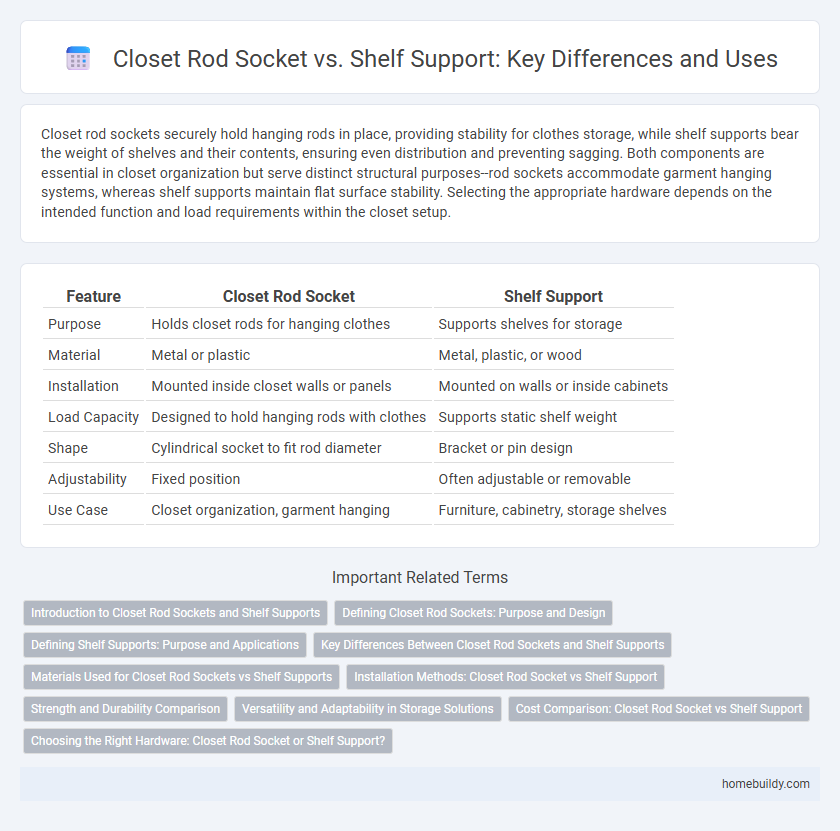Closet rod sockets securely hold hanging rods in place, providing stability for clothes storage, while shelf supports bear the weight of shelves and their contents, ensuring even distribution and preventing sagging. Both components are essential in closet organization but serve distinct structural purposes--rod sockets accommodate garment hanging systems, whereas shelf supports maintain flat surface stability. Selecting the appropriate hardware depends on the intended function and load requirements within the closet setup.
Table of Comparison
| Feature | Closet Rod Socket | Shelf Support |
|---|---|---|
| Purpose | Holds closet rods for hanging clothes | Supports shelves for storage |
| Material | Metal or plastic | Metal, plastic, or wood |
| Installation | Mounted inside closet walls or panels | Mounted on walls or inside cabinets |
| Load Capacity | Designed to hold hanging rods with clothes | Supports static shelf weight |
| Shape | Cylindrical socket to fit rod diameter | Bracket or pin design |
| Adjustability | Fixed position | Often adjustable or removable |
| Use Case | Closet organization, garment hanging | Furniture, cabinetry, storage shelves |
Introduction to Closet Rod Sockets and Shelf Supports
Closet rod sockets are designed specifically to securely hold closet rods, providing a stable support system for hanging clothes. Shelf supports, on the other hand, are engineered to bear the weight of shelving units, ensuring that shelves remain firmly in place. Understanding the distinct functions of closet rod sockets and shelf supports is essential for effective closet organization and maximizing storage efficiency.
Defining Closet Rod Sockets: Purpose and Design
Closet rod sockets are specifically designed components that securely hold closet rods, providing stable support for hanging garments and maximizing closet organization. Unlike shelf supports that primarily bear horizontal weight for shelving, closet rod sockets focus on fixing cylindrical rods in place, often featuring cup-shaped or bracket designs to prevent rod displacement. Their construction typically involves durable materials like metal or high-strength plastic to withstand daily wear and ensure long-lasting functionality.
Defining Shelf Supports: Purpose and Applications
Shelf supports are hardware components designed to hold and stabilize shelves within cabinets, closets, or storage units, ensuring weight distribution and structural integrity. Unlike closet rod sockets, which specifically anchor rods for hanging clothes, shelf supports accommodate flat surfaces and can vary from metal pins to decorative brackets, tailored for different load capacities and aesthetic preferences. These supports enable efficient use of vertical space by safely supporting items such as books, boxes, or folded garments.
Key Differences Between Closet Rod Sockets and Shelf Supports
Closet rod sockets are specifically designed to hold cylindrical rods securely for hanging clothes, providing stability and weight support tailored to garment storage. Shelf supports, on the other hand, are engineered to hold flat surfaces like wooden or glass shelves, focusing on evenly distributing weight across a horizontal plane. Key differences include their shape compatibility--cylindrical for closet rod sockets versus flat for shelf supports--and installation methods, with rod sockets often recessed into cabinetry while shelf supports may be surface-mounted or inserted into pre-drilled holes.
Materials Used for Closet Rod Sockets vs Shelf Supports
Closet rod sockets are commonly crafted from durable metals like steel or zinc alloy, offering robust support for hanging rods and ensuring long-lasting strength under weight. In contrast, shelf supports often utilize materials such as plastic, brass, or lightweight metals like aluminum, prioritizing flexibility and ease of installation over heavy load-bearing capacity. The difference in material composition directly affects the functionality and durability of closet rod sockets versus shelf supports, with metal sockets providing enhanced stability for clothing storage.
Installation Methods: Closet Rod Socket vs Shelf Support
Closet rod sockets install by mounting directly into the wall studs or side panels, secured with screws for sturdy support of hanging rods. Shelf supports typically require insertion into pre-drilled holes or brackets attached to panels, offering adjustable placement for shelving units. The direct fastening of closet rod sockets provides a robust hold for weight-bearing applications compared to the variable positioning of shelf supports.
Strength and Durability Comparison
Closet rod sockets are engineered to securely hold heavy closet rods and the weight of hanging clothes, offering superior strength compared to typical shelf supports designed primarily to hold flat shelving surfaces. Closet rod sockets are often made from robust metals like steel or zinc alloy, enhancing their durability under continuous load and reducing the risk of bending or breaking. Shelf supports, while useful for holding shelves, generally lack the reinforced structure needed for bearing dynamic loads, making closet rod sockets the preferred choice for long-term strength and durability in closet systems.
Versatility and Adaptability in Storage Solutions
Closet rod sockets provide superior versatility and adaptability in storage solutions by securely holding hanging rods for clothes, accommodating various rod sizes and weights. Shelf supports primarily stabilize fixed shelving, limiting flexibility for dynamic storage configurations compared to the adjustable nature of rod sockets. Incorporating closet rod sockets enhances customization in closet designs, optimizing space usage for diverse storage needs.
Cost Comparison: Closet Rod Socket vs Shelf Support
Closet rod sockets generally cost less than shelf supports, making them a budget-friendly option for hanging rods in closets. Shelf supports, designed to carry heavier loads and provide shelf stability, often come at a higher price due to their material strength and design. Choosing between closet rod sockets and shelf supports depends on both functional needs and budget constraints in closet organization projects.
Choosing the Right Hardware: Closet Rod Socket or Shelf Support?
Closet rod sockets provide secure mounting for closet rods, ensuring sturdy support for hanging clothes, while shelf supports are designed to hold horizontal shelving units with weight evenly distributed. Choosing the right hardware depends on your storage needs: opt for closet rod sockets when prioritizing hanging space and shelf supports for stable shelving surfaces. Consider material durability and installation type to match your closet design and maximize functionality.
Closet rod socket vs Shelf support Infographic

 homebuildy.com
homebuildy.com